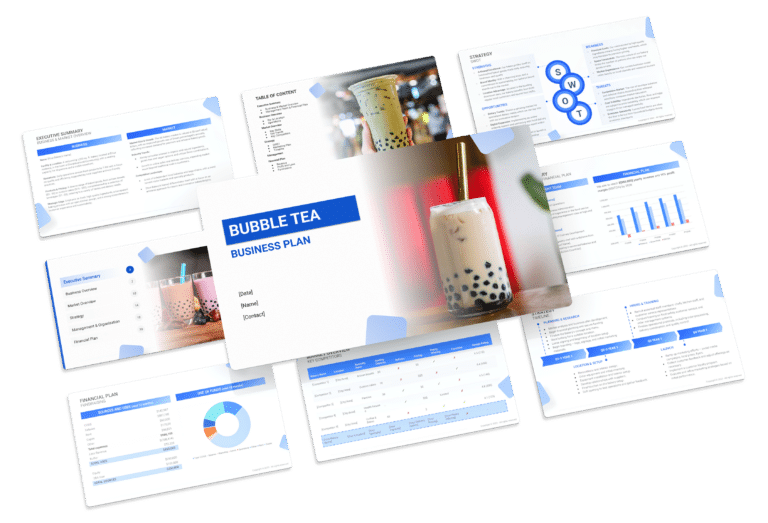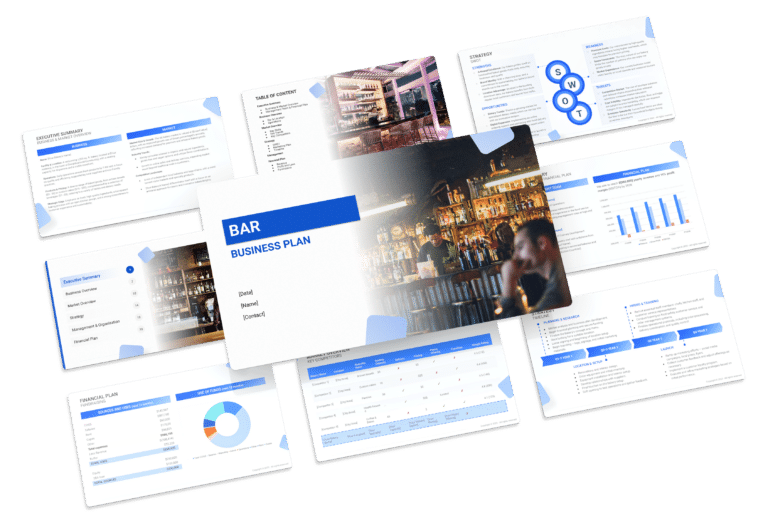SWOT Analysis for a Bakery (Example)

Conducting a SWOT analysis is vital when crafting a business plan for a bakery. SWOT, encompassing Strengths, Weaknesses, Opportunities, and Threats, aids bakery owners in assessing internal and external factors affecting their venture. While strengths and weaknesses are intrinsic aspects controlled by the bakery, opportunities and threats are external variables influencing business dynamics.
Integrating a SWOT analysis into the bakery business plan offers a comprehensive view of its position in the market, pinpointing avenues for growth and enhancement. For instance, strengths may include artisanal baking expertise and a loyal customer base, while weaknesses could involve limited marketing resources or dependence on seasonal ingredients.
This article will explore diverse examples of strengths and weaknesses, empowering bakery owners to strategically embed them in their business plans.

Strengths
- Quality Baked Goods: Your bakery’s strength lies in the quality of your products. The use of premium ingredients, skilled bakers, and consistent recipes ensures that customers receive delicious and freshly baked treats every time.
- Example: Your bakery’s signature artisanal bread, made from locally sourced organic grains and baked daily, has garnered a loyal customer following and rave reviews.
- Unique Product Offerings: Diversifying your product range with unique and innovative items sets you apart from competitors. Offering gluten-free, vegan, or specialty pastries can attract a wider customer base.
- Example: Your bakery’s gluten-free and vegan cupcakes have become a hit among health-conscious consumers, catering to dietary restrictions and preferences.
- Prime Location: A strategic location can be a significant advantage for a bakery. Being situated in a high-traffic area, near schools, offices, or tourist attractions, can lead to increased foot traffic and sales.
- Example: Your bakery’s downtown location near the city’s main transportation hub ensures a steady stream of customers, including commuters and tourists.
- Strong Brand Identity: A well-defined brand with a compelling story and attractive branding materials can create a strong connection with customers and foster brand loyalty.
- Example: Your bakery’s vintage-inspired branding and commitment to sustainability resonate with environmentally conscious consumers, reinforcing your brand’s identity.
Weaknesses
- Limited Operating Hours: If your bakery has limited operating hours, you may miss out on potential sales during peak demand times, such as breakfast or late-night snacking.
- Example: Your bakery currently closes at 6:00 PM, missing the opportunity to capture the post-dinner dessert market.
- Seasonal Variability: Seasonal fluctuations in demand for specific products can lead to inventory challenges and revenue inconsistencies.
- Example: During the holiday season, your bakery experiences a surge in demand for festive cakes, but managing inventory for the rest of the year becomes challenging.
- High Operating Costs: Maintaining high-quality standards can lead to elevated operating costs, impacting your bakery’s profitability.
- Example: Sourcing premium ingredients and adhering to strict quality control standards results in higher production costs, affecting your overall profit margins.
- Limited Online Presence: In today’s digital age, a weak online presence can hinder your bakery’s growth potential. An outdated website or lack of social media engagement can limit your reach.
- Example: Your bakery’s website lacks e-commerce capabilities, preventing customers from conveniently placing orders online, which is increasingly important in a post-pandemic world.
Opportunities
- Online Ordering and Delivery: Embracing online ordering platforms and delivery services can tap into a broader customer base, especially during the ongoing trend of convenience shopping.
- Example: Partnering with food delivery apps and offering online ordering enables customers to enjoy your bakery’s products from the comfort of their homes.
- Specialty Events and Catering: Expanding your services to include catering for events such as weddings, birthdays, and corporate meetings can open up a new revenue stream.
- Example: Your bakery can offer customized dessert tables and wedding cake designs, becoming the go-to choice for memorable celebrations.
- Sustainability Initiatives: Responding to the growing consumer interest in sustainable practices, adopting eco-friendly packaging and sourcing locally can enhance your bakery’s reputation.
- Example: Your bakery can reduce single-use plastic by switching to biodegradable packaging and supporting local farmers for fresh ingredients.
- Menu Innovation: Regularly introducing new and seasonal menu items can keep customers excited and encourage repeat visits.
- Example: Launching a limited-time summer fruit tart can generate buzz and attract customers looking for refreshing, seasonal treats.
Threats
- Intense Competition: The bakery industry is highly competitive, with new entrants constantly emerging. Established competitors and trendy cafes can pose a threat to your market share.
- Example: A new artisanal bakery has opened nearby, offering similar products and generating local buzz.
- Health and Dietary Trends: Evolving dietary trends and health concerns can impact consumer choices, making it crucial to adapt to changing preferences.
- Example: The rising interest in low-carb diets may affect the demand for your traditional bread products.
- Economic Downturns: Economic recessions and financial crises can lead to reduced consumer spending on non-essential items, affecting bakery sales.
- Example: During the recent economic downturn, your bakery saw a decline in sales as consumers tightened their budgets.
- Food Safety Regulations: Stringent food safety regulations and compliance requirements can lead to increased operational complexities and costs.
- Example: Recent changes in food safety regulations have necessitated additional staff training and equipment upgrades to maintain compliance.





